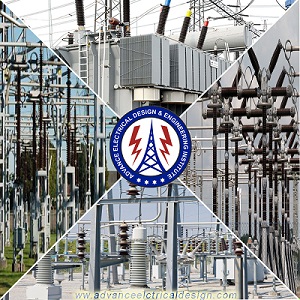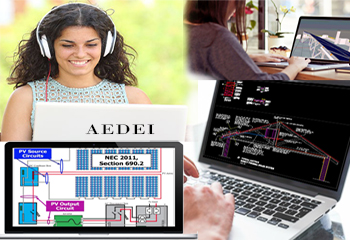Online Substation Design training Course
Solar Design Training Institute (SDTI) become India’s
Best instititute for technical Design Courses will providings online and Offline Substation Design
Training course which include Electrical Substation Electrical substations form important nodal
points in all power networks. Substations Design Course can be of various capacities, voltages,
configurations and types depending on what is the application for which the substation is being designed.
Location and layout of a substation present a number of challenges to the designer due to a large variety
of options available to a designer. There are ever so many constraints too that need to be kept in mind; technical,
environmental and naturally financial. Arriving at an optimum design within these constraints is as much an art as
it is a science. Designing a substation which will operate with utmost reliability for at the least three or four
decades involves a thorough knowledge of the current state-of-the art equipment, emerging technologies, the tools
for presenting and evaluating all available options and a good appreciation of power system operation and maintenance.
We will give detail design training on Online substation Design Course based on substation components
like will discusses some popular protection earthing systems, batteries and battery chargers,
AC and DC auxiliary systems and panels, power factor compensation (PFC) techniques, power quality
issues (such as harmonics, voltage flicker, sag, swell, etc.), and the impacts and applications of
embedded generation. In this training course, the participants will have the opportunity to
calculate fault currents and system impedances by means of Per Unit system, and practice power
system circuitry analysis, fault root cause analysis, propose appropriate protection schemes and
choose suitable CT’s, VT’s, and relays for different scenarios through industry-based practical
worked examples and mini projects to achieve an optimized and coordinated operation of control and
protection devices in typical complex power systems.
Who should attend:
 Anybody
who wants to gain valuable hands-on experience, especially electrical
and mechanical engineers; electrical and general contractors, electrical
designers, solar companies and solar industry professionals who want to
further their knowledge of solar design.
Anybody
who wants to gain valuable hands-on experience, especially electrical
and mechanical engineers; electrical and general contractors, electrical
designers, solar companies and solar industry professionals who want to
further their knowledge of solar design.
Prerequisites: Participants
should have a basic understanding of Electrical Engineering . Participants should also have
knowledge of Electrical.
What time: - Weekend Batch : Saturday and Sunday
- Time : 2 Hours/per day (Flexible timming as required)
How much: For Fees Details call Us +918467024957.. Fee includes course materials with Softwares .
How to Register:
We offer the following options to register for this class. Class size
is limited, so we recommend that you register early to guarantee a seat.
1. Online - click on the Enroll Now
button below and register using a credit card or check card. You will
be redirected to our online payment page for a safe, secure transaction.
You will receive an email confirmation when the transaction is
complete.
2. By phone – simply call us at (+91) 8467024957,7531923094 and we'll process your registration over the phone.
3. By whatApp on (+91) 8467024957,7531923094
4. Skype Id : aedei01
Syllabus of Online Substation Design Training Course

|
Online Substation Design Training
Module-1 Sub-Station Design Development
- Introduction to Bus-Bar Schemes
- Detail Study of One and Half CB Scheme
- Detail Study of Double Main and Transfer Bus Scheme
- Introduction to Key SLD
- Development of Detail SLD
- Introduction to Equipments
- Layout development from SLD
- Inter Coordination between SLD, Plan and Section
- Structure Loading Layout
- Clearance Diagram Development
- Cable Trench Layout Development
- EKD & BOM Development
Module-2 Sub-Station Design Calculations
- Rigid B/B Design
- Flexible B/B Design
- Wind Force Calculation
- Sag Tension Calculation
- Rigid SCF Calculation
- Flexible SCF Calculation
- Pinch Force Calculation
- Cantilever Strength Calculation
Module-3 DESIGN AND ENGINEERING OF SWITCHYARD
- Selection of project – Classification – Zone/Area wise
- Electrical Clearance of substation
- Insulation Coordinationcalculation of Equipment
- Outdoor Substation Layout
- Control Room Layout
- Types of bus-bar schemes of Substation
- Substation Main Equipment
- sizing of Transformers
- Reactive Compensation Equipment
- Shunt Capacitors
- Static VAR Systems
- Selection and Sizing of Voltage Transformers (VT) for switchyards
- Selection and Sizing of Current Transformers (CT)
- HT/LT Circuit Breaker Selection and Sizing
- Control& Relay Panels
- Standard Protection Schemes for Substation and Transmission line
- Substation Automation system design
- Selection of PLC, Communication protocol
- Benefits of Substation Automation system
- Substation Automation with IEC 61850 Standard
- selection and sizing of Disconnectors and earth switches (isolators)
- selection and sizing of Lightning Protection
- Selection of luminaries
- Selection and sizing of Bus Support Insulators
- Selection and sizing ofStrain Insulators
- Power line carrier Equipment (PLCC)
- Earthing of Switchyard
- Cabling of Switchyard
- Fire Protection Facilities in Substation
- DC Auxiliary supply/ Battery bank Sizing and selection
- Ref. Std
- IEEE Std 80-2000 :Guide for Safetyin AC Substation Grounding.
- IS 5613:Code of practice for design, installation and maintenance of overhead power lines,
- IEC 60071-2:Insulation co-ordination – Part 2:
- IEC: 62271-100:High-voltage switchgear and controlgear
- IEC 826-1991: Technical report on loading and strength of overhead transmission lines.
- IEC 60853:Sections on operating conditions – Reference operating conditions and selection of cable type
- IEC 60949:Calculation of thermally permissible short-circuit currents, taking into account non-adiabatic heating effects
- IS 3646: Code of Practice for Interior Illumination
|
Module-4 Cable Sizing and Selection of single Phase and Three Phase
- Load Details Calculation
- Cable type and Construction features
- Site Installation Conditions
- Cable Selection Based on Current Rating of feeder
- Base Current Ratings of feeder
- Installed Current Ratings of Cable
- Cable Selection and Coordination with Protective Devices
- Feeders load detail
- Motors load detail
- Voltage Drop of cable
- Cable Impedances
- Maximum Permissible Voltage Drop by ANSI and IEC std.
- Calculating Maximum Cable Length due to Voltage Drop
- Short Circuit Temperature Rise calculation of cable
- selection Minimum Cable Size Due to Short Circuit Temperature Rise
- Initial and Final Conductor Temperatures withstand capability of cable
Module-5 Earthing Design and Calculation of Power Plants
- Factors Influencing The Choice Of Earthed And Unearthed Systems
- System Earthing &Equipment EarthingConnections To Earth
- Resistance to Earth and Earth Electrode Current Density at The Surface of an Earth Electrode
- Selection of an Earthing Conductor and Connection af an Electrode
- Chemical Earthing Calculation
- Voltage Gradient around Earth Electrodes
- Connections to Earth Electrodes — Earthing And Protective Conductors
- Earthing Arrangement for Protective Purposes
- Earthing Arrangement for Functional Purposes
- Earthing Arrangements For Combined Protective And Functional Purposes
- Equipotential Bonding Conductors
- Typical Schematic of Earthing And Protective Conductors
- Earthing In Power Stations And Substations
- Earthing Associated With Overhead Power Lines
- Calculation of Earth Fault Currents
- Measurement of Earth Resistivity
- Measurement of Earth Electrode Resistance
- Measurement of Earth Loop Impedance
- Equipotential Bonding Conductors
Earhing Calculation For Switchyard And Power Plants
|

 Anybody
who wants to gain valuable hands-on experience, especially electrical
and mechanical engineers; electrical and general contractors, electrical
designers, solar companies and solar industry professionals who want to
further their knowledge of solar design.
Anybody
who wants to gain valuable hands-on experience, especially electrical
and mechanical engineers; electrical and general contractors, electrical
designers, solar companies and solar industry professionals who want to
further their knowledge of solar design.